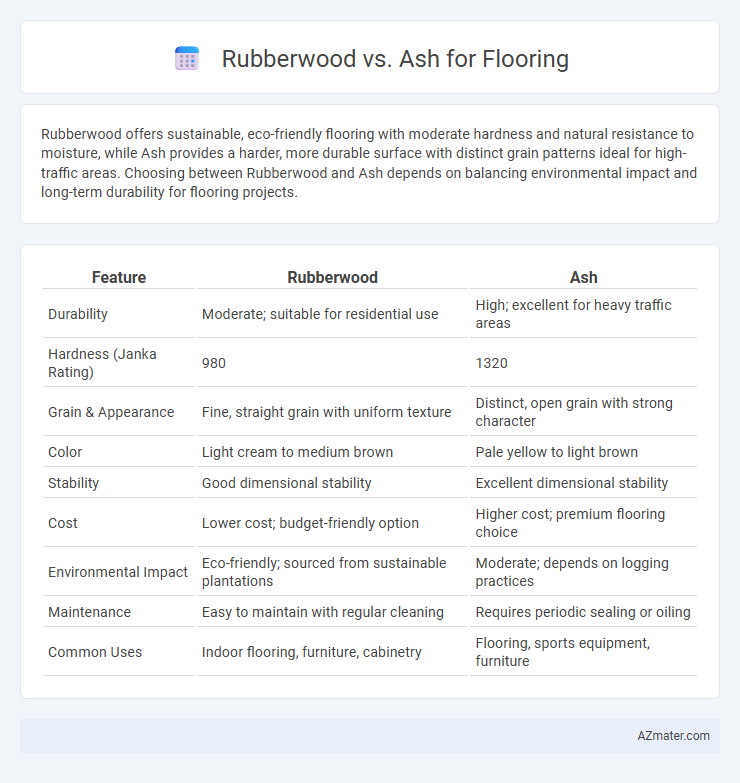Rubberwood offers sustainable, eco-friendly flooring with moderate hardness and natural resistance to moisture, while Ash provides a harder, more durable surface with distinct grain patterns ideal for high-traffic areas. Choosing between Rubberwood and Ash depends on balancing environmental impact and long-term durability for flooring projects.
Table of Comparison
| Feature | Rubberwood | Ash |
|---|---|---|
| Durability | Moderate; suitable for residential use | High; excellent for heavy traffic areas |
| Hardness (Janka Rating) | 980 | 1320 |
| Grain & Appearance | Fine, straight grain with uniform texture | Distinct, open grain with strong character |
| Color | Light cream to medium brown | Pale yellow to light brown |
| Stability | Good dimensional stability | Excellent dimensional stability |
| Cost | Lower cost; budget-friendly option | Higher cost; premium flooring choice |
| Environmental Impact | Eco-friendly; sourced from sustainable plantations | Moderate; depends on logging practices |
| Maintenance | Easy to maintain with regular cleaning | Requires periodic sealing or oiling |
| Common Uses | Indoor flooring, furniture, cabinetry | Flooring, sports equipment, furniture |
Introduction to Rubberwood and Ash Flooring
Rubberwood flooring, derived from the Para rubber tree, offers eco-friendly durability with a fine grain and light color that brightens interiors while resisting insect damage. Ash flooring, known for its prominent grain patterns and natural light beige tones, provides high strength and flexibility, making it ideal for high-traffic areas. Both options combine aesthetic appeal with functional resilience, catering to diverse design preferences in hardwood flooring.
Key Characteristics of Rubberwood Flooring
Rubberwood flooring is renowned for its durability, light color, and uniform grain, making it an attractive choice for modern interiors. The wood's high density and resistance to wear ensure a long-lasting surface ideal for high-traffic areas. Additionally, rubberwood is an eco-friendly option, sourced from plantations after latex extraction, contributing to sustainable flooring solutions.
Key Characteristics of Ash Flooring
Ash flooring is known for its durability and distinctive grain patterns, featuring light to medium brown tones with subtle reddish hues that enhance interior warmth. Its high density provides excellent shock resistance, making it suitable for high-traffic areas and resisting dents and scratches effectively. The natural flexibility and stability of ash make it a reliable choice for long-lasting hardwood flooring with a smooth, elegant finish.
Durability Comparison: Rubberwood vs Ash
Rubberwood offers moderate durability with a Janka hardness rating of approximately 980, making it suitable for low to medium traffic areas, but it is more prone to dents and scratches compared to ash. Ash wood boasts a significantly higher Janka hardness of around 1,320, providing superior resistance to wear and impact, ideal for high-traffic residential and commercial flooring. The durability advantage of ash ensures longer-lasting floors with less maintenance, while rubberwood's affordability balances its lower hardness in less demanding environments.
Aesthetic Differences and Visual Appeal
Rubberwood flooring offers a warm, light beige tone with a consistent grain pattern, creating a modern and minimalist aesthetic ideal for contemporary interiors. Ash flooring features a more pronounced grain with natural streaks and a pale, creamy color that adds visual texture and a classic, rustic charm to spaces. The choice between Rubberwood and Ash largely depends on whether a sleek, uniform look or a dynamic, character-rich appearance is desired for the flooring design.
Sustainability and Environmental Impact
Rubberwood flooring, sourced from the latex-producing Hevea brasiliensis tree, offers a sustainable option by utilizing plantation trees at the end of their latex cycle, reducing deforestation pressure. Ash wood, prized for its durability and grain, is harvested from hardwood forests that require longer growth cycles, which can contribute to habitat disruption and slower carbon sequestration compared to plantation-grown rubberwood. Evaluating environmental impact, rubberwood's fast renewability and lower carbon footprint make it a more eco-friendly choice for sustainable flooring solutions.
Installation Process: Rubberwood vs Ash
Rubberwood flooring offers a straightforward installation process due to its uniform grain and stable density, making it suitable for nail-down or glue-down methods. Ash flooring, known for its hardness and distinctive grain patterns, requires precise handling and is often installed using floating or nail-down techniques to prevent splitting. Both materials demand proper subfloor preparation, but Rubberwood typically provides easier workability and faster installation times compared to the more rigid Ash.
Maintenance and Longevity
Rubberwood flooring offers moderate durability with a lifespan of around 10-15 years and requires regular sealing to prevent moisture damage, while Ash flooring is known for its hardness and resilience, lasting 20-30 years with minimal maintenance. Ash's natural resistance to wear makes it ideal for high-traffic areas, needing only occasional refinishing to maintain its appearance. Rubberwood demands more vigilant care against scratches and humidity, but both materials benefit from routine cleaning and protective finishes to extend longevity.
Cost Analysis and Value for Money
Rubberwood flooring offers an economical option with moderate durability, typically priced lower than ash wood, making it suitable for budget-conscious renovations. Ash flooring, recognized for its hardness and attractive grain, commands a higher upfront cost but provides greater long-term value due to superior strength and resistance to wear. When evaluating cost analysis and value for money, ash flooring justifies its premium price through enhanced lifespan and aesthetic appeal, while rubberwood remains an affordable choice for less demanding applications.
Which is Better: Choosing Between Rubberwood and Ash for Flooring
Rubberwood offers a sustainable and cost-effective flooring option with moderate hardness and good durability, making it suitable for light to medium traffic areas. Ash, known for its superior hardness and attractive grain patterns, provides excellent wear resistance and longevity, ideal for high-traffic spaces. Choosing between Rubberwood and Ash depends on balancing budget constraints with desired durability and aesthetic preferences.

Infographic: Rubberwood vs Ash for Flooring
 azmater.com
azmater.com